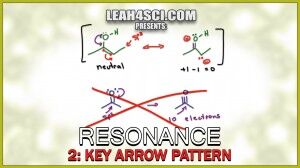 Understanding resonance structures is the first step. Knowing which electrons CAN and CAN'T is key to figuring out how to draw additional resonance structures.
Understanding resonance structures is the first step. Knowing which electrons CAN and CAN'T is key to figuring out how to draw additional resonance structures.
This video shows you what to avoid when drawing resonance, followed by key arrow patterns to look out for in determining additional structures.
(Watch on YouTube: Key Arrow. Click cc on bottom right for video transcription.)
<– Watch Previous Video: What is Resonance?
–> Watch Next Video: Major and Minor Resonance Structures
Tutorial Video
Ready to test your resonance skills? Try my FREE Resonance Practice Quiz.
This is Video 2 in the Resonance Structures Video Series. Click HERE for the entire series.
Don’t miss the Written Tutorial Formal Charge Formula and Shortcut for Organic Chemistry that is also apart of the Resonance Series.



thank you so much for this videos…i’m having my exam in 2days and all im doing is going through your video..thank you again…
do you have the solution of the assignment?
Hi Leah! I LOVE your site!!! In you example of 1,3- butadiene, the first Carbon loses it’s pi bond and therefore cannot fulfill the octet rule. Do can carbons in resonance structures violate this rule?
Great video! I have a question, though: In rule number 3, in that first resonance structure, didn’t the first carbon of the chain violate the octet? It seemed to have 6 electrons around it.
Thanks!